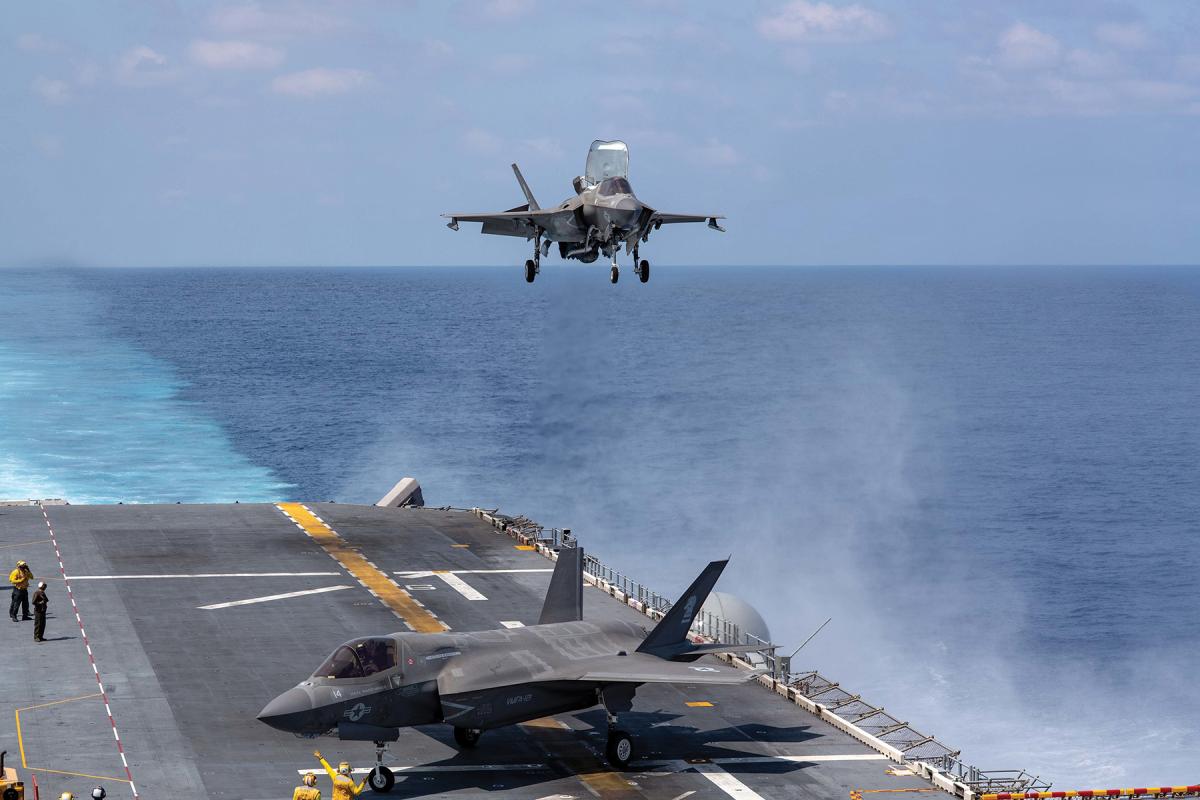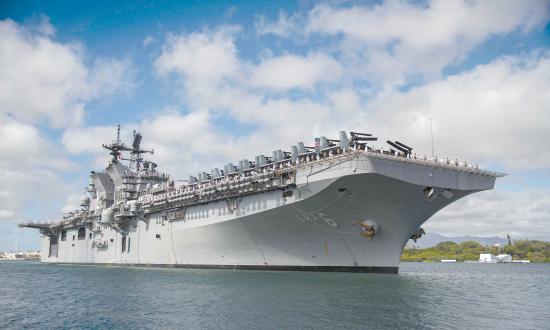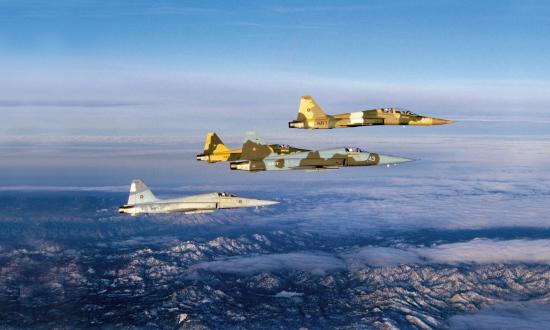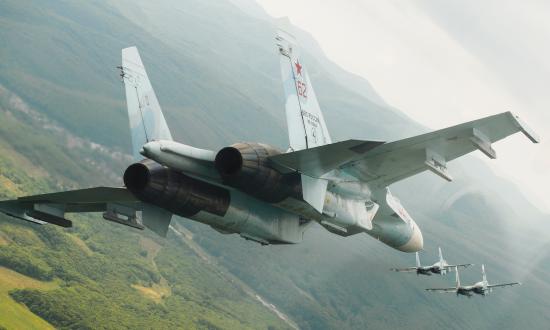As the Navy and Marine Corps adapt to distributed maritime operations and distributed lethality, the types of aircraft carriers and their roles also must adapt. The Navy and Marine Corps are becoming more dispersed and more lethal by divesting from large platforms that “unduly affect the whole of the Navy shipbuilding budget” in favor of smaller ships capable of generating distributed fires across a wide expanse of geography.1 This force structure change not only calls into question the future role of the large combatants naval aviation depends on to get to the fight—such as nuclear powered aircraft carriers (CVNs) and amphibious assault ships (LHAs and LHDs)—but also the availability of the traditional escort platforms—cruisers and destroyers—that protect them. Naval aviation must adapt and leverage its ability to deliver distributed precision fires and real-time command, control, computers, communications, intelligence, surveillance, and reconnaissance (C4ISR) in a contested environment.
THE NAVY’S EVOLVING FORCE STRUCTURE
The Navy and Marine Corps are moving toward a more integrated yet more dispersed force in place of traditional carrier strike groups (CSGs). In its 2017 Surface Force Strategy, the Navy coined its desire to send more ships further, faster, and more frequently into contested environments as “distributed lethality.”2 As carrier strike groups are held at risk farther from the battlefield by the proliferation of antiaccess/area-denial (A2AD) threats—including long-range antiship missiles (ASMs) and submarine threats—the Navy increasingly will need smaller surface combatants—including unmanned platforms—to pierce the weapons engagement zones of our adversaries and generate distributed fires.
In a recent interview with Defense News, Chief of Naval Operations Admiral Michael Gilday emphasized the Navy’s need to get away from wrapping “$2 billion ships around 96 missile tubes” to “fight a potential adversary that is producing capability and platforms at a very high rate of speed.”3 This high rate of adversary production is exemplified by the 100 modern submarines the Chinese People’s Liberation Army–Navy is projected to field by 2030—compared to the U.S. Navy’s estimated 53.4
Commandant of the Marine Corps General David Berger’s 2019 Commandant’s Planning Guidance identifies a similar need to “seek the affordable and plentiful at the expense of the exquisite and few.”5 Essentially, the Navy must improve its weapon-to-target cost ratio against peer adversaries by denying them the opportunity to take out $15 billion platforms, such as Gerald R. Ford–class carriers, with $1 million missiles.6
Naval aviation must embrace distributed maritime operations by finding the optimal balance between distributing airframes over multiple platforms and maintaining the capability to refuel, rearm, and service aircraft in a cost-effective manner. In the third edition of his much celebrated work, Fleet Tactics and Naval Operations, renowned naval strategist Captain Wayne Hughes, U.S. Navy (Retired), claimed that a commander is “better off with twice as many units of force than units with twice the rate of effective fire power.”7 Deploying dispersed, smaller combatants in place of traditional strike groups forces an adversary to solve the complex, resource-heavy problems of finding, tracking, and targeting each individual combatant, as opposed to a large ship or formation. While smaller combatants cannot pack as much capability and capacity as traditional escort platforms, dispersing a greater number of them across a larger operating area would increase their staying power relative to single large formations—a significant advantage inside the first island chain in the western Pacific or in the Persian Gulf. When a fleet is able to coordinate multi-node fire, distributing capacity across multiple platforms has the added benefit of increasing combat power. Figure 1 illustrates this concept through three hypothetical engagements.
THE CARRIER STRIKE GROUP IN DISTRIBUTED MARITIME OPERATIONS
While distributed maritime operations provide significant advantages to the surface fleet, can a smaller, more dispersed force replace traditional CVNs and their cruiser/destroyer escorts? The Navy and Marine Corps are facing the seemingly diametrically opposed tasks of preparing for a potential near-peer conflict while maintaining a vital presence in the Middle East. In the South China Sea and Persian Gulf, the Navy and Marine Corps must be prepared to both combat maritime insurgencies and deliver overwhelming high-end capability when challenged. In these roles, distributing aircraft across multiple platforms could be a better model for naval aviation and the fleet as a whole.
The vulnerability and high cost of CVNs impose a high level of risk in contested environments. When it comes to countering maritime insurgencies, the response of CSGs is essentially limited to freedom of navigation operations (FO-NOPs), which brings expensive, “exquisite” platforms within the engagement zone of fast attack craft and ASMs. Counterinsurgency strategies are commonly defined as either enemy-centric, in which degrading the enemy’s ability to operate is the focus, or population-centric, in which the on-the-ground (or on-the-water) outcomes for the local population are the focus.9 The peaceful and transitory nature of FONOPs means they do little to diminish the enemy’s ability to operate or to maintain a desired status quo for the local population.10 Deploying several smaller, less costly ships over a wide expanse of geography—and quickly massing them when challenged—would better support counterinsurgency operations by allowing the Navy to respond at the first sign of illicit activity while maintaining the ability to overmatch adversaries through network-enabled, coordinated fires.
Distributed maritime operations require naval aviation support that CVNs are not best suited to provide. More, smaller aircraft carriers could provide a better match between missions, resources, and risk tolerance.
FUTURE FORCE STRUCTURE
The Navy could maximize the unique advantages naval aviation brings to distributed maritime operations by investing in more modern, conventional, “lightning” carriers or CVLs.11 Like the World War II–era escort carriers (CVEs) before them, lightning carriers would be smaller and less expensive than CVNs. Based on the design of current LHAs, CVLs would carry Navy and/or Marine F-35Bs and include additional fuel and armament capacity by removing the troop spaces for nonaviation-related Marines.
According to a recent RAND study, three CVLs could deploy and sustain as many aircraft in a contested environment as a CVN at a lower cost. While the newest aircraft carrier in the fleet, the USS Gerald R. Ford (CVN-78), will cost the taxpayer over $15 billion and took eight years to deliver, smaller-deck, F-35B compatible ships—such as Wasp-class LHDs—cost an estimated $1.5 billion and take two years to build.12
Escort carriers played an indispensable role in the Pacific theater during World War II. Initially built to escort transport convoys to Europe and Asia, CVEs soon earned a reputation as formidable fighting ships by conducting antisubmarine warfare in advance of larger carriers, providing close air support for amphibious landings, and winning surface engagements against much larger battle groups—such as in the Battle of Leyte Gulf.13 By assigning CVEs to specific roles in a larger operation—such as close air support—naval aviators became highly proficient in specific mission types, embarking airframes and armaments on the CVE responsible for their specialty.14 When needed for major fleet-on-fleet engagements, three CVEs with 30 planes each were able to mass their capacity to generate more sorties collectively than a single big-deck carrier with 90 planes.15 The ability of CVEs to fulfill multiple roles as distributed assets, and mass to become a formidable force, gave big-deck carriers free rein to strike the Japanese homeland and Chinese coast.16
Investing in modern lightning carriers (CVLs) would allow naval aviation to provide broader support to more widely dispersed surface groups, bring high-end capability to the fight without holding more costly CVNs at risk, and coordinate strikes and C4ISR across a multinode network in a contested environment. Reorganizing fleets around standoff CVNs and forward positioned CVLs would allow naval aviation to deliver greater capability and capacity than traditional CSGs, more dispersed around and within an enemy’s threat umbrella, at a lower weapon-to-target cost-ratio. While CVLs would not be any less susceptible to enemy detection than CVNs or LHA/LHDs, allowing them to operate independently or with limited escorts would be cheaper than operating traditional CSGs, distribute firepower and assets more widely, and complicate enemy search, tracking, and targeting efforts.
Lightning carriers loaded mainly with a single type of aircraft, such as the F-35B, could move in and out of an A2/AD threat envelope while delivering localized precision fires. At the same time, CVNs could stay outside the threat envelope but deliver long-range effects using EA-18 Growlers, F-35Cs, and F/A-18 Super Hornets—refueled by MQ-25A Stingrays. CVL-based ISR assets, such as MQ-8 Firescout unmanned helicopters, could provide over-the-horizon targeting data and real-time situational awareness for networked combatants inside or outside an enemy’s weapons engagement zone. And CVLs could act as rearming and refueling “lily pads” for manned and unmanned platforms heading to or back from the fight.
Projecting naval power in tomorrow’s contested environments will require distributed maritime operations. The Navy and Marine Corps can maximize the capabilities of naval aviation by integrating their aviation assets, experimenting with tactics that mix CVNs and LHA/LHDs today, and investing in lightning carriers—CVLs—for the future.
1. Bradley Martin and Michael McMahon, Future Aircraft Carrier Options, (Santa Monica, CA: RAND Corporation, 2017) i, ix.
2. “Surface Force Strategy: Return to Sea Control.” www.public.navy.mil/surfor/Documents/Surface_Forces_Strategy.pdf
3. David B. Larter, “CNO Sounds Off: The Drift, Season II, Vol. IV,” Defense News, 11 December 2019, www.defensenews.com/naval/the-drift/2019/12/11/cno-sounds-off-the-drift-season-ii-vol-iv/.
4. Patrick Cronin et al., Beyond the San Hai: The Challenge of China’s Blue-Water Navy (Washington, DC: CNAS, 2017), 8–9.
5. General David H. Berger, USMC, Commandant’s Planning Guidance (2019), www.hqmc.marines.mil/Portals/142/Docs/%2038th%20Commandant%27s%20Planning%20Guidance_2019.pdf?ver=2019-07-16-200152-700
6. Ronald O’Rourke, “Navy Ford (CVN-78) Class Aircraft Carrier Program: Background and Issues for Congress,” Congressional Research Service (March 2020), pp. 4-5. crsreports.congress.gov/product/pdf/RS/RS20643
7. Wayne P. Hughes and Robert Girrier, Fleet Tactics and Naval Operations (Annapolis, MD: Naval Institute Press, 2018), 42.
8. Hughes, 277-278
9. Christopher Paul, et al, Moving Beyond Population-Centric vs. Enemy-Centric Counterinsurgency, Small Wars & Insurgencies, 27:6, 1019–1042, www.tandfonline.com/doi/abs/10.1080/09592318.2016.1233643
10. Hunter Stires, “The South China Sea Needs a ‘COIN’ Toss,” Proceedings, May 2019, www.usni.org/magazines/proceedings/2019/may/south-china-sea-needs-coin-toss
11. Megan Eckstein, “Marines Test ‘Lightning Carrier’ Concept, Control 13 F-35Bs from Multiple Amphibs,” USNI News, 23 October 2019, https://news.usni.org/2019/10/23/marines-test-lightning-carrier-concept-control-13-f-35bs-from-multiple-amphibs.
12. Forecast International. Warship Forecast: LHD-1 Wasp Class, (Washington Navy Yard: Naval Sea Systems Command, September 2010), 8. www.forecastinternational.com/archive/disp_pdf.cfm?DACH_RECNO=798
13. Price Gilbert, The Escort Carriers in Action, the Story, in Pictures, of the Escort Carrier Force, U.S. Pacific Fleet, 1945 (Atlanta: Ruralist Press, 1946) 13.
14. Gilbert, 14
15. Ibid.
16. Martin, ix.






